|
Getting your Trinity Audio player ready...
|
Established in 1929
No matter the season, the Grand Tetons will mesmerize you with their majestic presence. You can find them rising royally in a glacial lake of icy blue waters or as a backdrop to a wildflower-strewn summer meadow full of wildlife. The picturesque jagged peaks create an unforgettable vista.
There is something indescribably magnetic about the pyramidal pinnacles of the Teton Mountains. Looking over the skyline of the range, it’s hard not to wonder what lies nestled in the valleys and saddles between the peaks. This is the home of bighorn sheep, of things that thrive where humans rarely go. The spires of rock are sliced by deep box canyons, speckled with glaciers, grooved into by trickles of icy water. Below the peaks, a sweeping, grassy plain sprawls. Bison, moose, and elk graze on the banks of placid, ancient lakes, each babbling into the enigmatic Snake River. In a word, the entire landscape is enchanting.
If you’ve never seen Grand Teton National Park, you probably won’t understand how it feels to be right in the middle of it. So we decided to put together a guide to the park for newbies and lifers alike, to pass on all the reasons to go, and some of the ways you can spend your time there. If you’re planning a trip to Teton, or have never even thought of going, start your journey here. This is the Essential Adventure Guide to Grand Teton National Park.
Jackson Hole Campervan Rentals: Explore Grand Teton and Yellowstone National Parks in a fully stocked Moterra Campervan rental in Jackson, Wyoming. All of our rentals are four-wheel-drive (4×4) Mercedes Sprinter campervans, so that you can experience these rugged Wyoming treasures with complete comfort and capability.
Human History of The Tetons
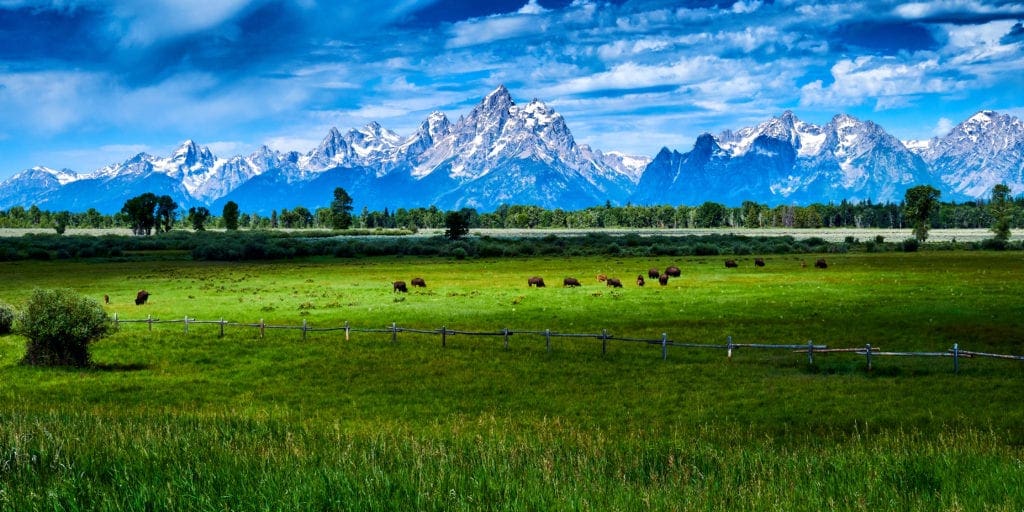
Bison grazing in the Teton Valley near Grand Teton National Park, Wyoming.
Before the end of the last ice age, human beings were already trekking into the high country below the snowcaps of the Teton range. They followed populations of elk along migratory routes that are still followed by the animals with each winter freeze and spring thaw to this day. Among them were the Clovis people, which is thought to be the earliest widespread human culture to live in North America. The Clovis culture spread and changed over time, giving rise to most modern Native American cultures.
By the time that European eyes first fell on Teton Valley, the Shoshone were its primary residents. These particular tribes relied on bighorn sheep as a staple food source. The Teton Mountains were held sacred in their beliefs, and there is evidence that they may have actually been the first to ascend the Grand Teton during spiritual voyages into the unknown. Early European mountaineers found human-made structures high in the mountains, known simply as “Enclosures”. The highest of these sits just 500 feet below the summit of the Grand Teton, the second highest point in the range.
The first white explorer to see the Teton range was John Colter, notably the first American mountain man, and a member of the Lewis and Clark Expedition. In 1808, Colter detached from the expedition to head south, passing through Teton Valley and Jackson Hole before heading west. This set a precedent of famous mountain men visiting the area, including Jim Bridger, Jedediah Smith, and Davey Jackson, for whom Jackson Hole is named.
Over the course of the next fifty years or so, concerted efforts to protect the Tetons would eventually lead to the naming of the park. This decision was hotly debated by locals, who primarily made their livings ranching. Grand Teton National Park was set aside in 1929, and later added to with a large private parcel previously owned by John D. Rockefeller.
All the while, mountaineers had been racing to climb the peaks and high points of the Tetons. It’s most likely that the Grand Teton was first summited (if not by native peoples) by the Owen-Spalding group, in August of 1898. Since then, the Tetons have been a hub for sport climbing and alpinism alike, drawing prominent athletes like Glenn Exum and John Gill. And the rich history of people climbing the awesome peaks of the Teton Mountains continues to this day. As it stands, Grand Teton is home to some of the most intense alpine climbing and ski mountaineering in the lower 48 states.
Geology
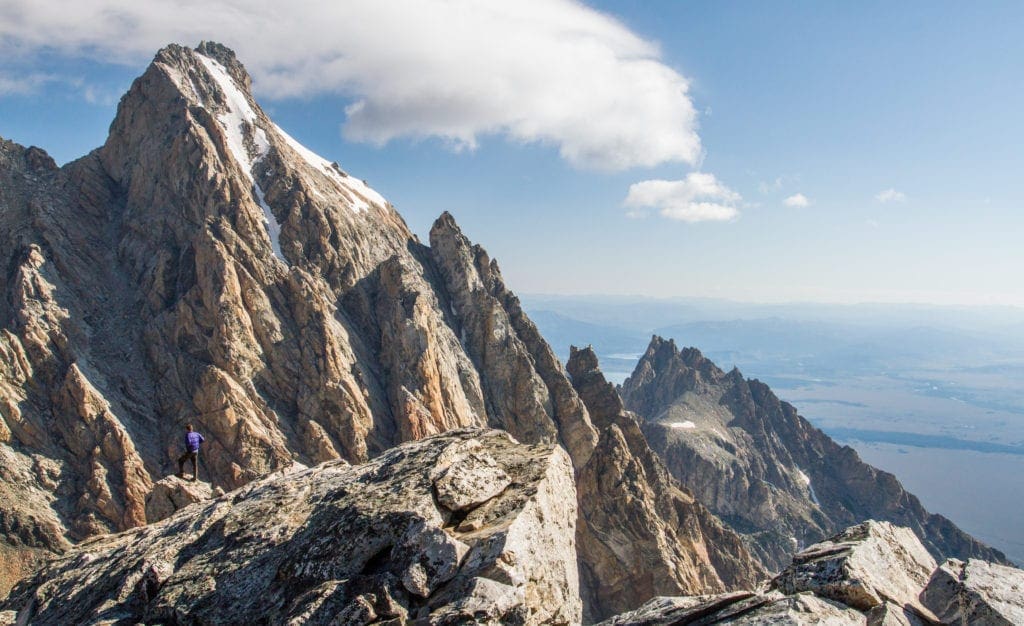
A mountain climber in Grand Teton National Park, Wyoming
The Teton Mountains are the youngest subordinate range within the Rockies, forming roughly six to nine million years ago. They are a prime example of fault-block mountains, wherein a fault rises on one side and drops on another. This is what causes the steep drop off on the eastern aspect of the Tetons, where the western aspect rolls more gradually away. This process of uplift is happening fairly rapidly, with earthquakes occurring every 3-400 years, resulting in each side of the fault rising and dropping about a foot. The rapid growth of the range is evident in its prominence – the Grand Teton sits at 13,775 feet, with nine other peaks in the range over 12,000.
But what causes the actual shape of the Tetons is extensive glaciation and weathering by water. The Tetons are littered with impressive canyons, both U-shaped box canyons resulting from ancient glaciers and V-shaped canyons arising from creeks. The action of water on the landscape is very apparent here. Due to the high annual snowfall and extant glaciers, the Tetons are rich with fresh running water, cutting drainages deeper with each passing season. This in turn feeds the process of frost wedging, cleaving chunks of rock from the slopes.
Flora and Fauna
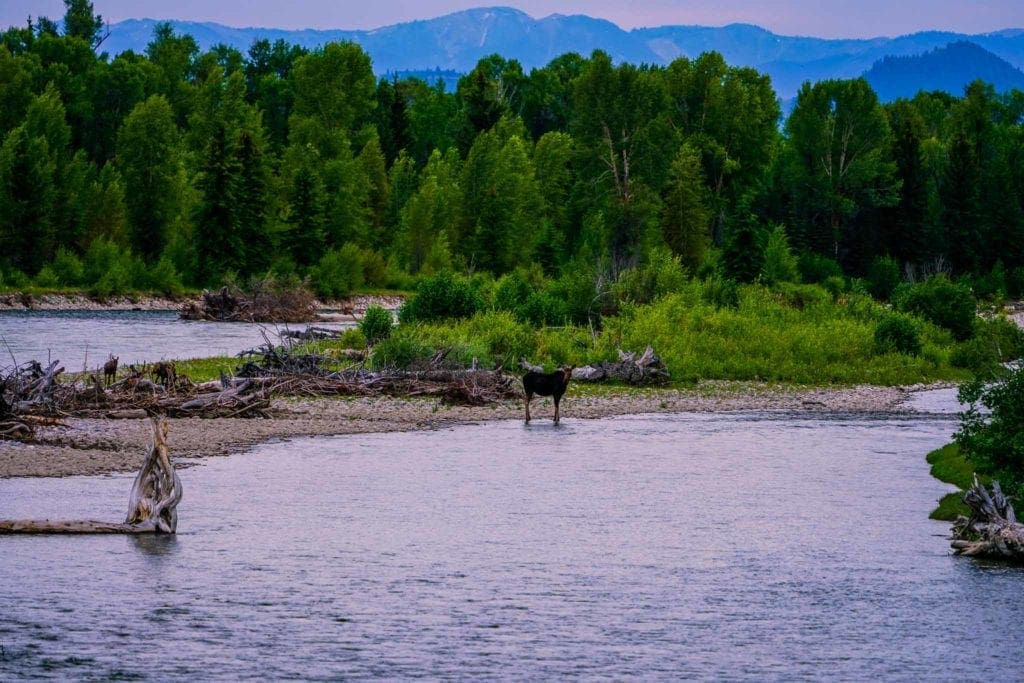
View of a wild female moose cow and her two calves on the Snake River in Grand Teton National Park in Wyoming, United States
Maybe the most impressive part of northwestern Wyoming is the wildlife. Grand Teton National Park is part of the Greater Yellowstone Ecosystem, which supports an absolutely astounding number of mammals, along with fish, birds, and amphibians. It is commonly referred to as an “intact ecosystem”, meaning all of the area’s native species are still living and coexisting as they have since the last ice age.
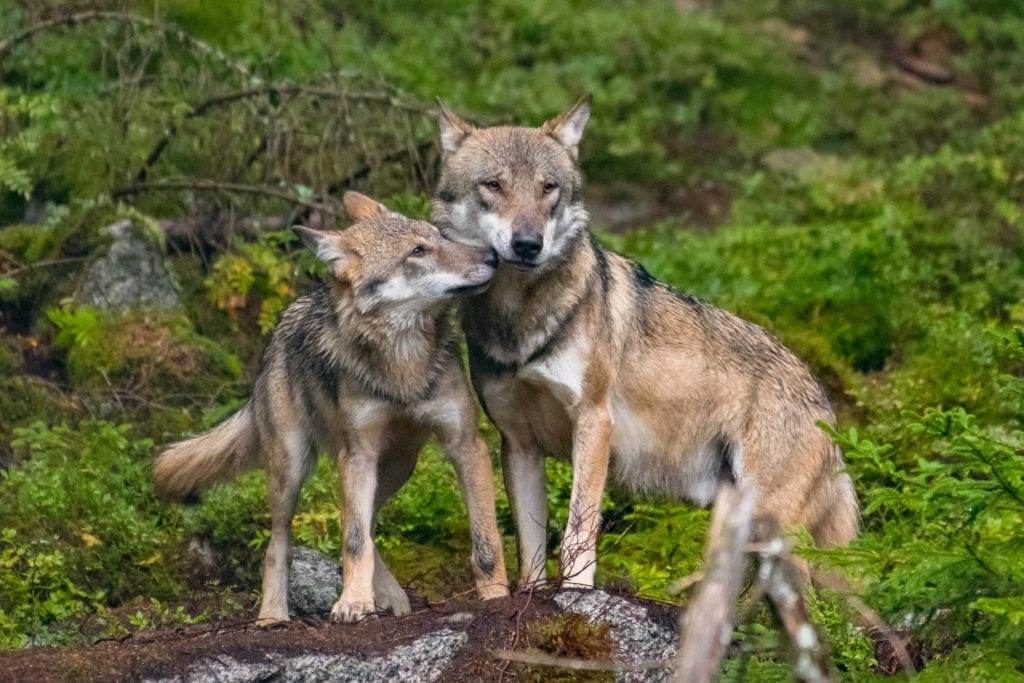
Grey wolfs (Canis lupus) standing on a rock.
Perhaps the most recent change to this arrangement was the reintroduction of the gray wolf, which was extirpated in the early 20th century. Gray wolves are apex predators, controlling the populations of every animal that they eat, which in turn controls the density of vegetation. This cascade of effects can have long-reaching consequences. For example, without the influence of wolves, elk and moose populations may increase, which may in turn decrease the number of riparian plants like willows, which hold the banks of rivers in place. Thus, if the willows are browsed away, the shape of a river may change over time. Reintroducing wolves was a step in the right direction toward restoring the park to its primordial state.
On an average day in early summer, driving through Grand Teton, you could easily expect to see any of the following: moose that stand taller than a man at the shoulder, herds of elk, bison grazing in open fields, black and grizzly bears of five different colors rummaging under fallen logs with their new cubs, beavers swimming through flat water on the Snake River, porcupines, soaring hawks, colorful sandhill cranes, great blue herons, ospreys, and bald eagles. But the park holds a whole host of incredible wildlife beyond this. Cougars, river otters, pine martens, mountain goats, bighorn sheep, harlequin ducks, even lynx and wolverines frequent the park, though they’re rarely seen by visitors. This amazing wildlife spectacle draws enthusiasts from around the world, some of which follow individuals over the course of their lives. One famous grizzly bear, known as 399, has what could be called a “cult following” of adoring fans.
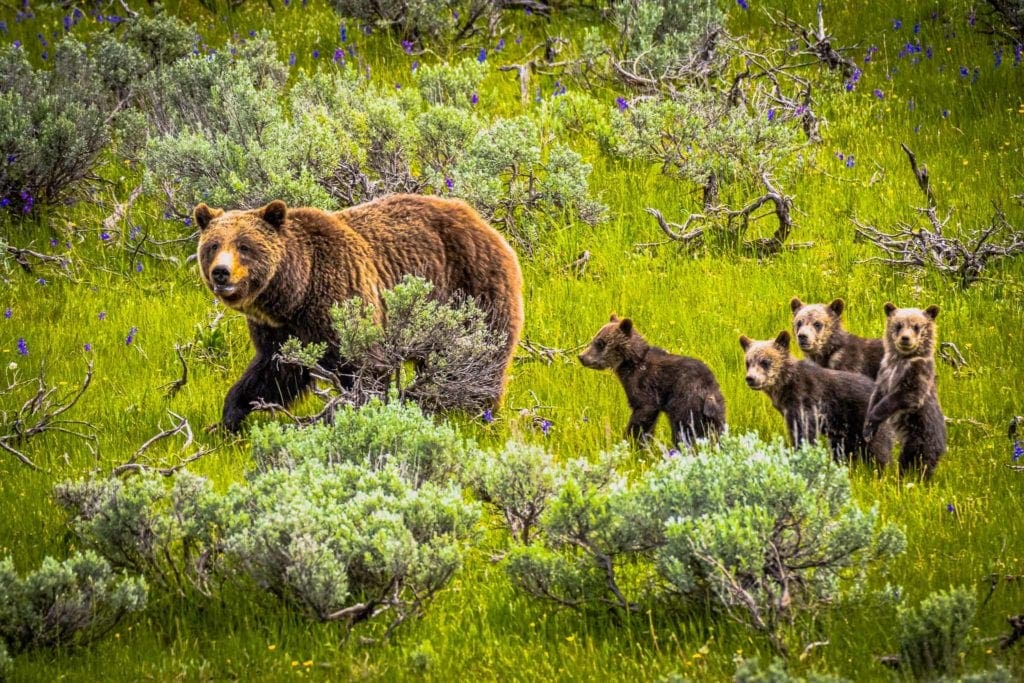
Grizzly bear #399 with her cubs in Grand Teton National Park, Wyoming.
If you plan on visiting Teton, taking some time out to do some wildlife watching is an absolute must. During the late spring and early summer, bears are common in the northern part of the park’s lowlands, feasting after hibernation. In the fall, open fields fill up with elk practicing their annual mating ritual, called rutting. In the southern part of the park, flat stands of tall cottonwood trees are frequented by huge moose, browsing on broadleaf vegetation. Further east, herds of bison congregate to graze and, if you catch the timing just right, butt heads.
Bring a pair of binoculars and prepare to be awed. But do so cautiously, and maintain a safe distance while viewing wildlife. Wild animals can and will kill if they feel cornered or stressed by human activity. Worse yet, animals that have protected themselves from human interaction are often labeled “problem animals” and euthanized. To maintain the wildness of Grand Teton, always show respect to the locals – that is, the spectacular creatures that live in the park year round.
Main Attractions
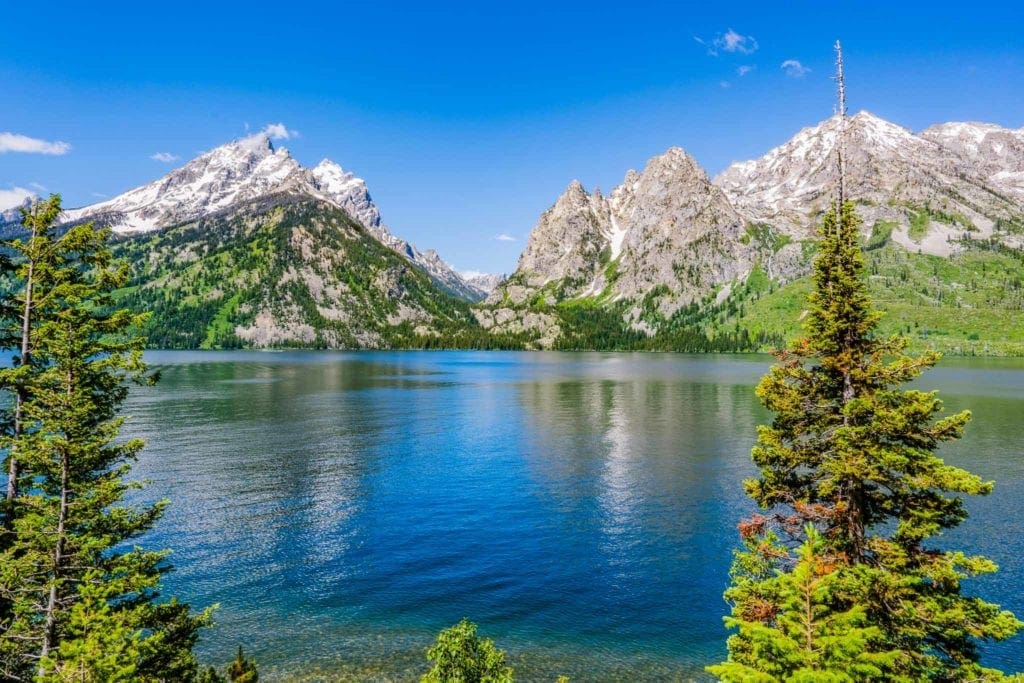
Jackson Lake at Colter Bay in Grand Teton National Park, Wyoming
How you experience Grand Teton will depend quite a bit on what you plan to do while you’re there. But there are a few stops along the park’s main roads that every first time visitor should be sure to see. As you head north from Jackson, the summits of the Tetons will come into view over a rise. Before long, you’ll be presented with the turnout to Moose, where the park’s visitor center and headquarters are. Taking this turn puts you on the “inside road”, which follows the foot of the peaks more closely. This scenic drive is unbeatable, and a top notch place to see wildlife. Make a stop at Jenny and Leigh Lakes, two of the park’s most pristine. You can hike around and admire the Grand Teton up close, or take a ferry to the far side of Jenny Lake.
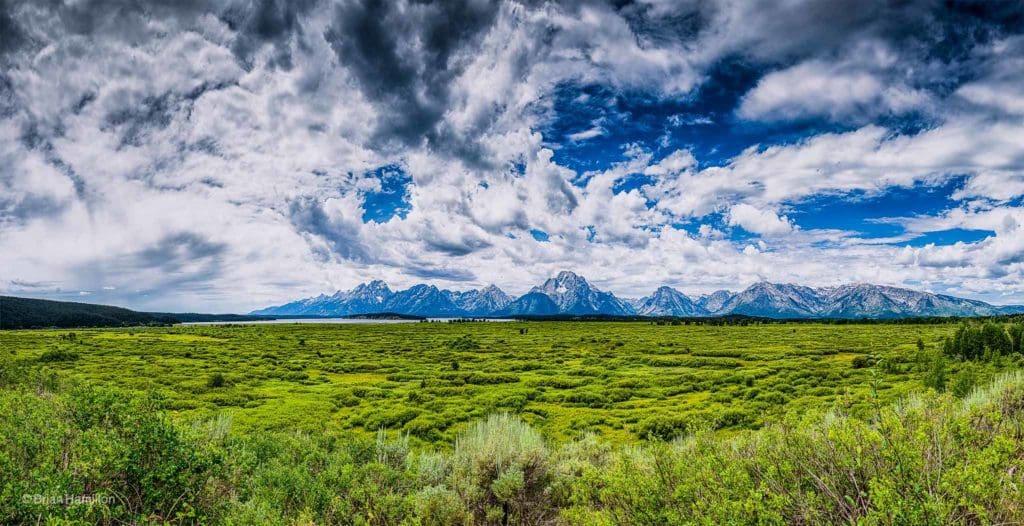
Expansive meadow with Jackson Lake and the Tetons in the background, as seen from the back patio of Jackson Lake Lodge.
Continuing north, you’ll come to Jackson Lake, a huge body of water over 400 feet deep. If you have some kind of watercraft with you, this is a fantastic spot to paddle around. If not, you could rent one at Colter Bay. If you’re in the mood for libations and food, stop over at Jackson Lake Lodge, a cozy spot overlooking a willow flat on the edge of Jackson Lake that is a common haunt for grizzly bears. Trending further north, you’ll get views of the northern mountains in the Teton range, including Moran, a standout for its shape and the aptly-named Skillet Glacier on its east face. Depending on how you pace yourself, and if you take time out to hike, this tour of the park could easily take all day.
Hiking
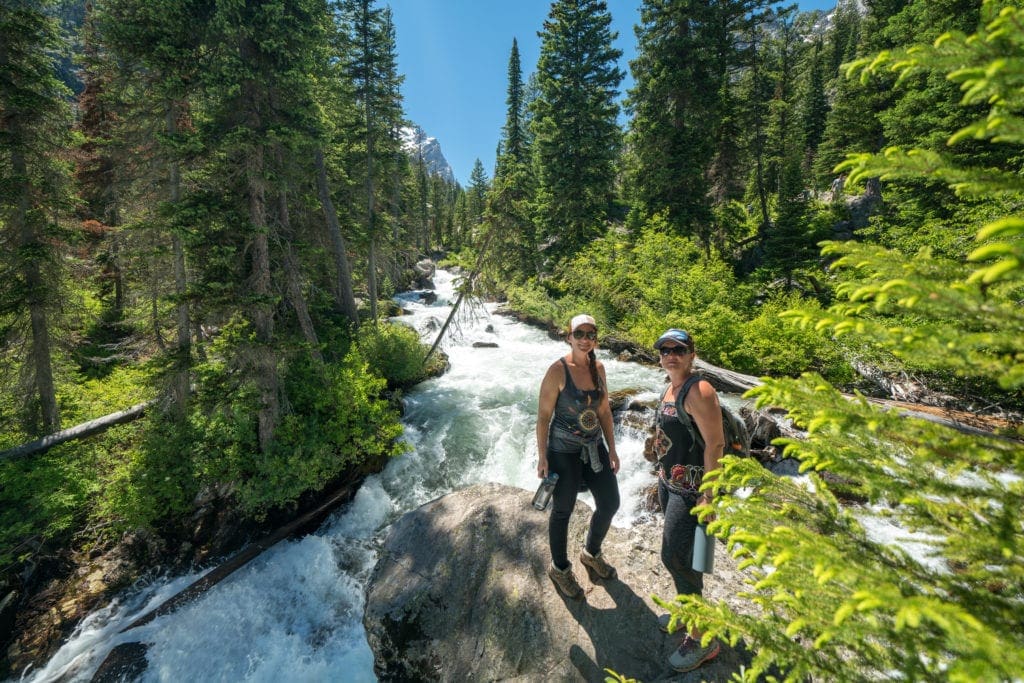
Hiking through Cascade Canyon Trail to Hidden Falls of Grand Teton National Park, Wyoming.
Obviously, the best way to get up into the mountains is on foot. Grand Teton National Park is teeming with stupendous hikes, ranging from mellow to technical and strenuous. For beginners and newcomers to the park, be sure to check out Jenny Lake, String Lake, and Leigh Lake. There is a system of loop hikes around each that is mostly flat and highly rewarding. For some more distance, you could hike around Emma Matilda or Two Ocean Lakes, further east in the valley, which stay less crowded throughout the year.
If you have the time and energy, definitely try and get up into one of the Park’s many canyons. Death Canyon, Paintbrush Canyon, Granite Canyon, and Cascade Canyon are all outstanding treks starting in the lower valley that progress steadily upward into massive forests of douglas fir and subalpine spruce, past waterfalls and old Park cabins into the high alpine. There are a few high points accessible by the canyons that don’t quite qualify as mountaineering, depending on the season. The Middle Teton has an easy route up its southwest couloir, rated third class scrambling over talus. The South Teton can also be summited non-technically. For fit hikers looking to get a little more hands-on, either or both of these summits is a worthy day outing.
Camping
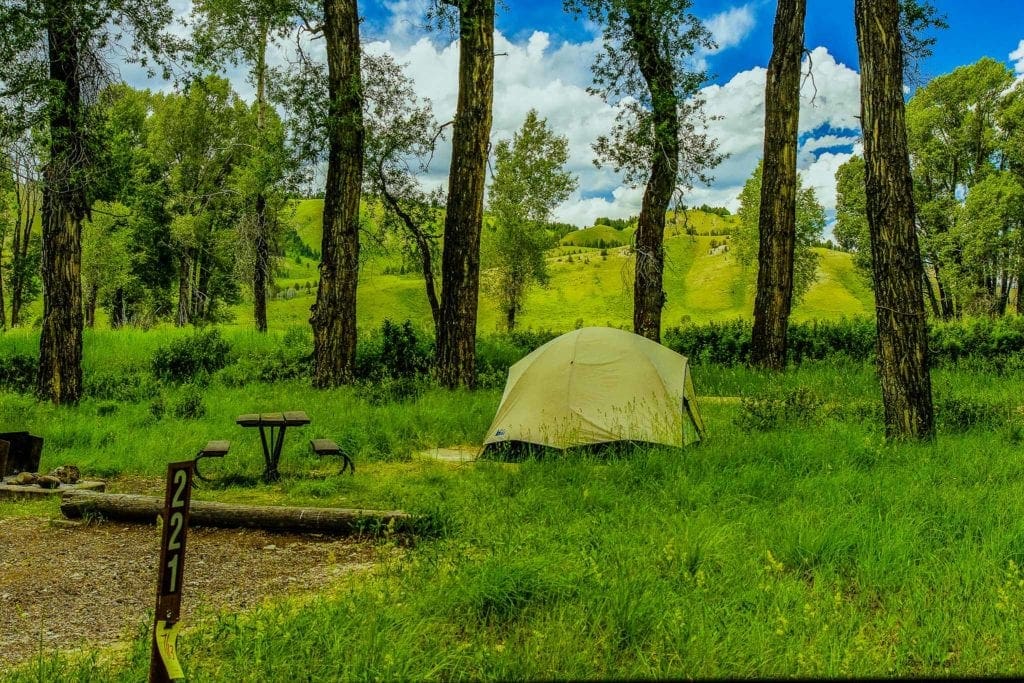
Gros Ventre Campground in Grand Teton National Park in Wyoming.
Grand Teton National park offers more than a couple beautiful patches of ground where you can pitch your tent. If you can book a site far enough in advance, Jenny Lake Campground is one of the best spots in the park. It sits in front of the lake, right at the base of the Grand Teton, and is surrounded on all sides by dense pine trees and wildlife. The main downside is that it can be crowded in the peak of the season. In the fall, Gros Ventre Campground is a no-brainer. The campground is full of huge cottonwood trees, and come October they litter the ground with bright yellow leaves. You’ve also got good odds of spotting huge moose and herds of elk here, which is a big plus during the elk rut. For more solitude, check out Lizard Creek Campground on the northern side of Jackson Lake. If you have a kayak or canoe, this is the place to be. You can put in at your camp and spend the day paddling around the lake. Colter Bay and Signal Mountain Campgrounds are also wonderful, with a similar experience to what you would get at Jenny Lake. Consider these as a backup if your first choice isn’t available during peak season, before looking elsewhere.
For budget campers, there are also free primitive sites located just outside the park boundary. If you take the Outside Road (from Jackson, go straight at the Moose turnout), you can turn toward the Gros Ventre Campground and Kelly and proceed out of the park boundary to Shadow Mountain. This area is protected by the Forest Service, and camping at existing fire rings is allowed without a fee. Just be sure not to make new fire rings and follow the Leave No Trace code of ethics.
Backpacking
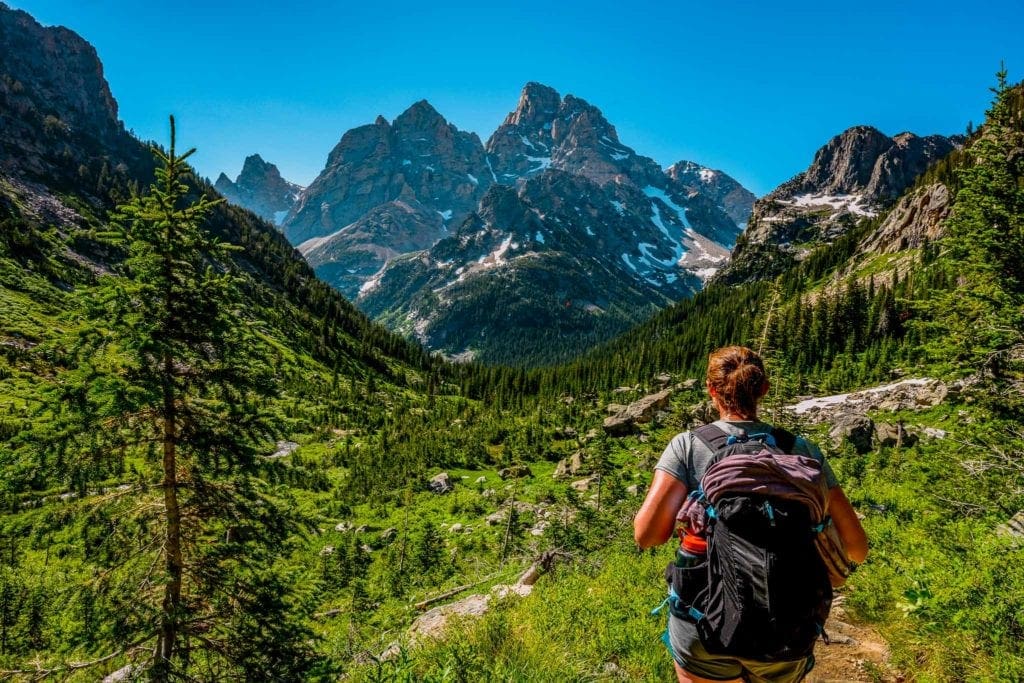
A backpacker looks Out Over Tetons Wilderness on sunny summer day.
Overnighting in the Teton backcountry is an experience that any backpacker would remember forever. Head up any of the major canyons and you’ll eventually hit the main backcountry thoroughfare through the park, the Teton Crest Trail. This trail connects all of the major canyons together, along with most of the high points in the range. You can camp at backcountry campsites along this route, or, if you’re unable to get permits, you could dip out of the park boundary along the Teton Crest Trail into Alaska Basin, which is managed by the Forest Service and does not require a fee for overnighting.
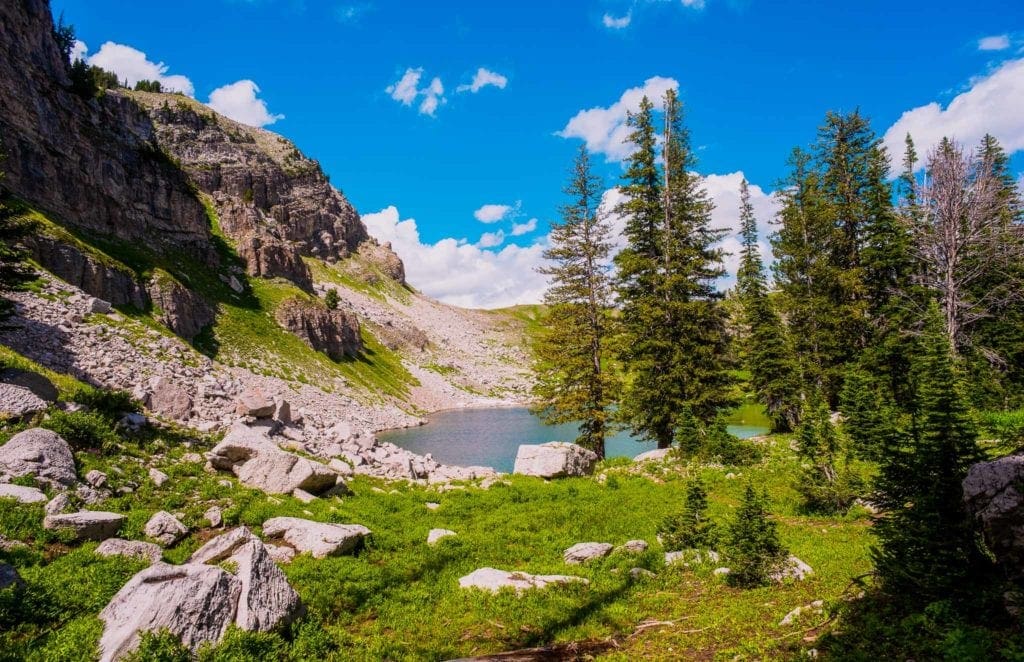
Beautiful views from the Teton Crest Trail.
There are tons of combinations of ways up and down from the high alpine along the Teton Crest Trail, along with places to camp. Depending on how long you want to stay and what other objectives you have in the backcountry, you could do anything from an overnighter to a solid week in the Teton backcountry. But the Crest Trail isn’t the only way into the backcountry.
For a completely different experience, look into Webb Canyon. It’s isolated from the others that run along the Crest Trail, making the way in hard. Your options are to hike in from the John D. Rockefeller parkway to the north, or grab a canoe and paddle in across Jackson Lake from the east side. Webb, and its neighbors, Owl and Berry Creek are lush mountain canyons rarely hiked by visitors, and as such are teeming with bears. As always, when hiking in bear country, you should know the ins and outs of avoiding and dealing with wildlife encounters. But for those who dare, Webb Canyon will show you a side of the park that most visitors never get to see.
Paddling, Boating, and Floating
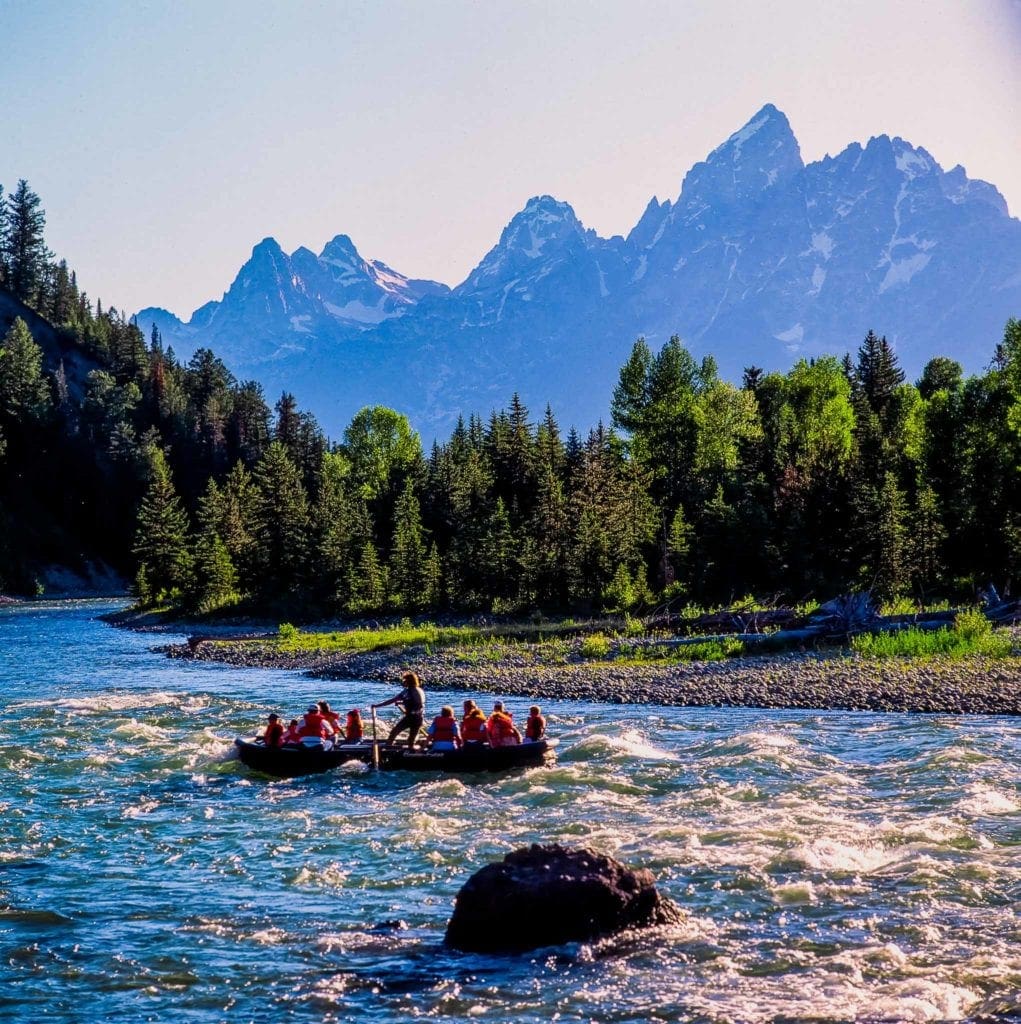
Rafting on Snake River; Grand Teton National Park, Wyoming.
For lovers of watercraft, Grand Teton is a paradise. The park offers pristine mountain lakes, rivers, and further downstream, intense whitewater on the Snake. For paddleboarders, String and Leigh Lakes are ideal. They feature still water, with lots of small coves and inlets to meander around at your own pace. If you’ve got a motorized boat, you can put in on Jenny and Jackson lakes and speed around to your heart’s content. Jackson Lake is also a great spot for kayaking and canoeing. There are several small islands in the lake, and paddling out to explore them on foot is one of the purest ways to see the Tetons in all their glory, from a perfect distance. In fact, you can even get a permit to camp on Elk Island. If packrafting or overnighting by boat is your particular flavor, this adventure is a must.
There are also tons of options for floating the Snake River, either in the park, or further south, which is primarily whitewater rafting (see the Big Kahuna and Lunch Counter rapids if you love whitewater). But in the park, several sections of the Snake can be floated in smaller watercraft at a lazy pace, which is ideal for fishermen and wildlife lovers. For example, the section between Jackson Dam and Pacific Creek follows a mostly flat section of the river and is frequented by beaver, bald eagles, elk, and bears – not to mention all of the feisty brown trout you could catch.
Horseback Riding
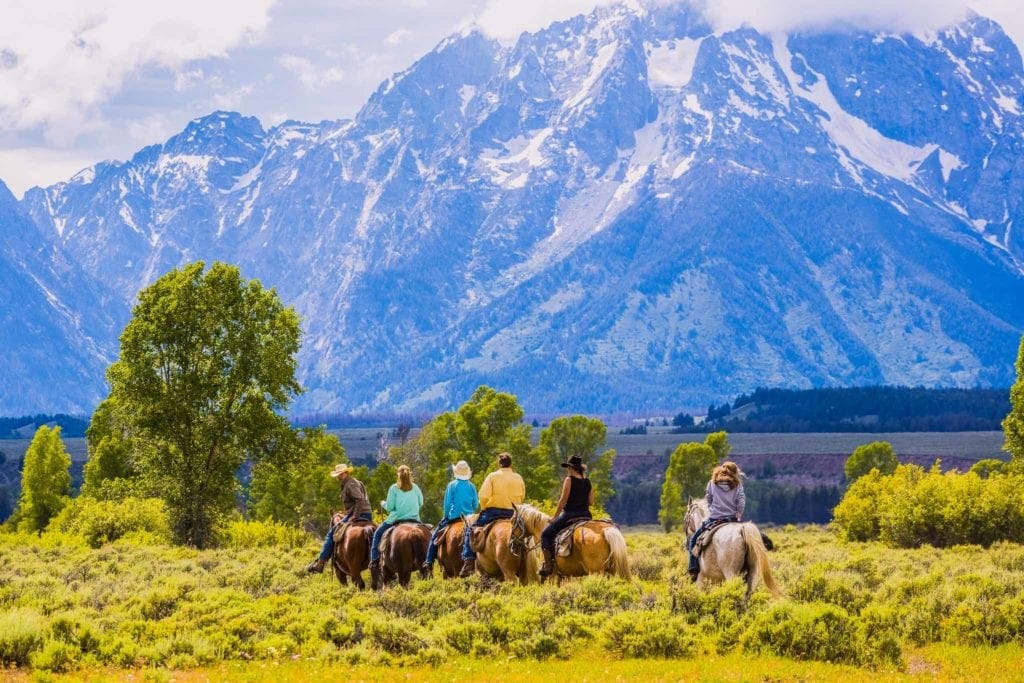
Horse riding in Grand Teton National Park, Wyoming.
Grand Teton may be the best place on earth to get a hearty taste of the Old West. The area is chock full of historical dude ranches where you can stay overnight, eat, and go out on day activities like horseback riding. Check out Headwaters Lodge, the Grand Teton Lodge Company, and Triangle X Ranch for details. You can also bring your own stock animals into the park. Horses, burros, mules, and llamas are all allowed on certain trails around the park. Be sure to read up on stipulations regarding stock animal use before you go.
Climbing and Mountaineering
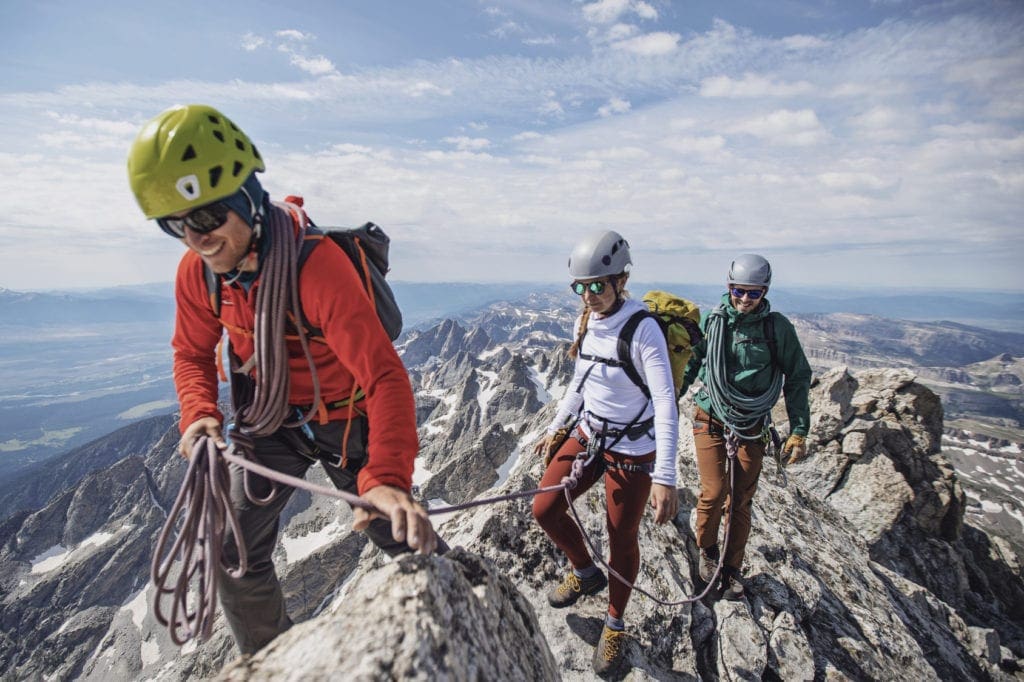
Climbing guide leads two clients to the summit of the Grand Teton.
Climbing in the Tetons is a tradition that goes back hundreds and thousands of years. As a climber with diverse tastes, you could spend a decade in the Jackson area and not see it all. Most noteworthy, of course, are the major high points that can be acquired in the Teton range. The most essential of these is, of course, The Grand, sitting at a peak elevation of 13,770 feet. The routes to its summit vary greatly in difficulty, with something most competent climbers could take on. The Owen-Spalding (class II, 5.4) is most commonly taken by first timers, but others like Exum Ridge (5.5, 5.7) are worth the additional effort. Further, the North Face of the peak is considered a training ground for Alaskan mountaineering with unbelievable mixed rock and ice climbing. See Bean’s Shining Wall of Storms (5.12-) and North Buttress Direct (5.10+ R).
If you’re not feeling a technical route, or are new to mountaineering, you could take on something easier like the Middle or South Teton. For something entirely different, check out Symmetry Spire, with several routes from 5.6 to 5.8 or Mount Moran, most commonly approached by the easiest route, rated class III 5.4.
For sport enthusiasts, Blacktail Butte near Moose is a hub for difficult, polished limestone. Classics like The Arch (5.12a), Graceland (5.11c), and Blitzkrieg (5.11d) will push your limits without all the commitment of a long alpine route. And if your tastes lie more along the lines of a chilled out bouldering session by a lake, head to Jenny Lake and check out Red Cross Rock. There’s a good diversity of difficulty here, from V2 to V9, with outstanding scenery. The Gill Route (V7) is a historical classic problem first ascended by Jim Gill, and a standout for testing your mettle against the old pros.
Skiing
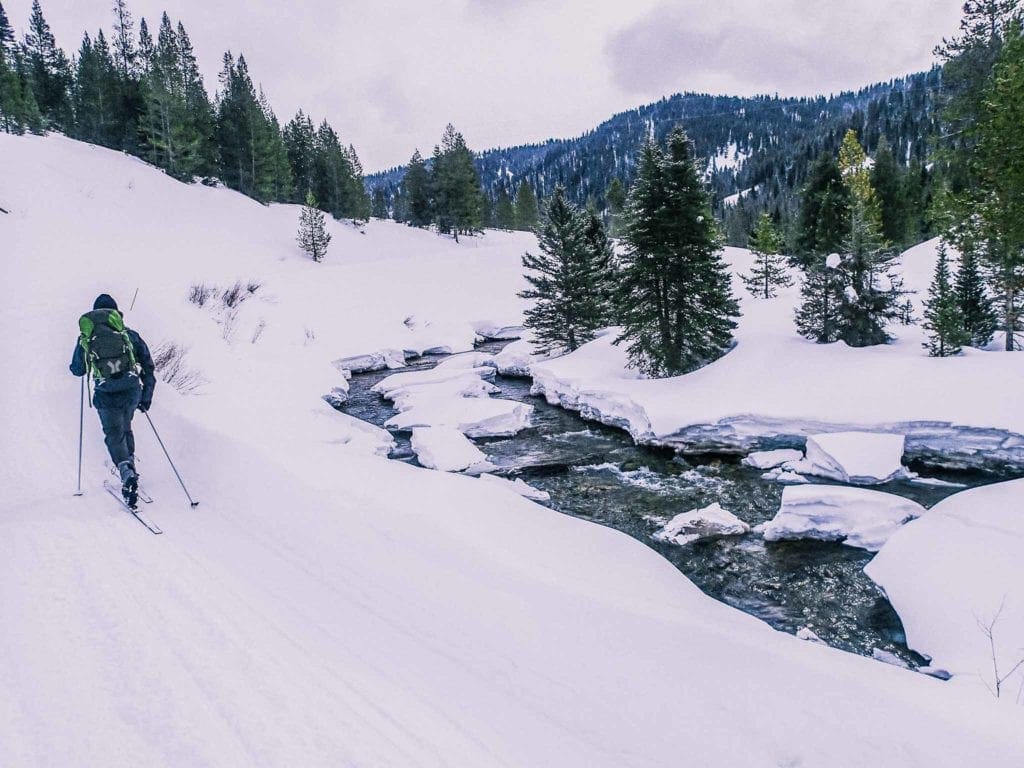
Cross Country Skier in Snowy Winter Landscape in Jackson, Wyoming.
Come winter, the fun doesn’t stop in Teton. Just outside the park boundaries is one of the best ski resorts in the United States, Jackson Hole Mountain Resort. If you make a trip during the winter, prepare to learn the meaning of “steep and deep”. The Tetons are known for their big mountain terrain and powder. One of the resort’s most picturesque and purely frightening features, Corbet’s Couloir, features a mandatory air into unbelievable steeps. The chute draws huge crowds annually for a freestyle competition called the Kings and Queens of Corbet’s, which has repeatedly been a showcase of the cutting edge of all-mountain freestyle skiing and snowboarding for several years.
But there’s plenty you can do in the park on skis as well. The Ford-Stettner Couloir set the bar for big lines in the range by being the first descent of the Grand Teton on skis. But don’t think you have to go this big to get your feet wet skiing the Tetons. Especially come spring, there are plenty of options for folks of most all ability levels to set out on. You can tour up easy slopes and ski perfect corn until your legs fall off, or grab your ice axes and gun it up one of the many chutes the range offers. If you want to maximize your fun, The Middle Teton, Mount St. John (on the far side of Jenny Lake), and Teewinot Mountain are good options come late season, with a wide spread of options for newbies and hardcore ski mountaineers.
The Good, The Great, and The Grand
Grand Teton National Park has always represented a sprawling buffet of options for adventure. Whether you’re a newcomer to adventure sports or a professional, you’re almost guaranteed to fall in love with the inspiring peaks of the Tetons. There’s enough here for a lifetime, maybe several, and whether or not you’ve got that kind of time, you should absolutely make the journey to this still-untamed part of the world. Happy exploring.
Enroll With Global Rescue Prior To Embarking On Your Next Adventure.
When a travel emergency arises, traditional travel insurance may not come to your aid, and a medical evacuation can cost up to $300,000.
The cost when you have a Global Rescue membership? $0. That’s why when the unexpected happens, you want the leader in rescue, evacuation and medical advisory behind you. You want Global Rescue.
Terms of Use: As with each guide published on SKYBLUEOVERLAND.com, should you choose to this route, do so at your own risk. Prior to setting out check current local weather, conditions, and land/road closures. While taking a trail, obey all public and private land use restrictions and rules, carry proper safety and navigational equipment, and of course, follow the #leavenotrace guidelines. The information found herein is simply a planning resource to be used as a point of inspiration in conjunction with your own due-diligence. In spite of the fact that this route, associated GPS track (GPX and maps), and all route guidelines were prepared under diligent research by the specified contributor and/or contributors, the accuracy of such and judgement of the author is not guaranteed. SKYBLUE OVERLAND LLC, its partners, associates, and contributors are in no way liable for personal injury, damage to personal property, or any other such situation that might happen to individuals following this route.











